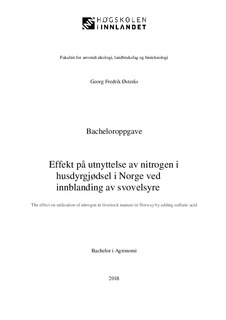Effekt på utnyttelse av nitrogen i husdyrgjødsel i Norge ved innblanding av svovelsyre
Bachelor thesis
Permanent lenke
http://hdl.handle.net/11250/2502642Utgivelsesdato
2018Metadata
Vis full innførselSamlinger
Sammendrag
Formålet med dette studiet var å undersøke
effekten på utnyttelse av nitrogen i husdyrgjødsel
i Norge ved innblanding av svovelsyre.
Det ble
brukt litteratur og forsø
k fra Danmark
, Sverige
og
Tysklan
d
for å danne grunnlag for
en helhetlig konklusjon
med utgangspunkt i eget
feltforsøk.
I eget forsøk ble
avlingsforskjeller mellom svovelsy
retilsatt husdyrgjødsel,
ubehandlet husdyr
gjødsel og gylle (
50 %
husdyrgjødsel og
50 %
vann)
undersøkt.
Tilsetting
av svovelsyre i gjødsla gav 27 prosent større avling sammenlignet med
ubehandlet gjødsel.
Gyllen gav 20 prosent økt avling sammenlignet med den ubehandlede gjødsla.
U
tenlands
ke
forsøk viste også en økt
total
avling
på mellom
12 og 20 prosent
ved tilsetting av svovelsyre
sammenlignet med ubehandlet gjødsel.
Ammoniakktapet reduseres be
tydelig ved
senkning
av pH
i
husdyrgjødsla
under
pH
6,0.
Utenlandske forsøk viste en reduksjon
av ammoniakktapet
på mellom 50 og 79 prosent
.
D
et
var størst reduksjon
i ammoniakktap, og
bedre
effekt av p
H
-
senkning ved spredning i varme
og tø
rre
værforhold.
Det finnes flere metoder for p
raktisk utførelse av pH
-
senkning
.
I dette studiet vurderes
tilsetting av svovelsyre under opprøring av
gjødsellager
, samt
tilsetting av svovelsyre under
spredning
,
å være de mest aktuelle metodene for norsk landbruk.
Begge disse
anleggene
er
mobile
, og
e
t
t anlegg
kan betjene
mange
gårdsbruk
.
Hovedfunnene i dette studiet er at tilsetti
ng av svovelsyre i husdyrgjødsel
gir bedre utnyttelse
av nitrogenet og økte avlin
ger
ved spredning under varme og tørre værforhold.
Ammoniakktapet blir
kraftig
redus
ert ved svovelsyretilsetting, og effekten er størst ved
spredning i høy temperatur uten nedbør.
Tilsetting av svovelsyre gjør at man
ikke er avhengig
av svært lav tørrstoffprosent eller
kjølig og fuktig vær
for god utnyttelse av nitrogenet i
husdyrgjødsla. The pu
rpose of this study was to
assess
what effects
adding sulfuric acid
to livestock manure
in Norway
had on the utilization of the nitrogen
.
L
it
erature and trials f
rom
Denmark, Sweden
and
Germany
were used to
form
th
e basis for a comprehensive conclusion
based on my own
field trial
.
Differences in yield
between different
manure
treatments
was investig
ated
in my
own field trial
.
The differe
nt
manure
treatment
s
w
ere
acidified manure, untreated manure and
manure with lower dry matter content (50
% manure and 50
% water)
.
By adding sulfuric acid
to the manure, an increase in yield by 27 percent was
observed
compared to untreated
manure
.
The
manure with low dry matter content
yielded 20 percent higher compared to untreated
manure.
T
rials from the other countries showed an increase in yield by 12 to 20 percent by
adding sulfuric acid to the manure compared to
untreated manure.
The
ammonia losse
s
is significantly
reduced by
decreasing the slurry pH to below 6,0.
A
reduction
of
ammonia
losse
s by 50 to 79 percent is p
roved
in studies f
rom Sweden
, Germany
and Denmark
.
The greatest reduction of ammonia loss
is
observed
in warm and dry
w
eather
conditions
.
Similarly
,
the effect of lowering the
pH in
manure
is
greater
when the m
anure
i
s
spread in dry and wa
rm weather
conditions.
It is
several different methods
of adding sulfuric acid to livestock manure.
The study suggests
that acidification of
manure
in storage a
nd
during application in the field is tw
o methods
applicable
for
Norwegian
agriculture.
B
oth systems are mobile, an
d
one unit
can serve
several
farms.
The main
findings in
this
study wa
s that by adding sulfuric acid to livestock manure, the
utilization of nitrogen is
better
and
yields
are increased
under warm and dry weather
conditions.
The loss of ammonia is significantly reduced by addi
ng sulfuric acid to the manure,
and the effect of lowering the pH is greates
t when manure is spread in dry an
d warm weather
conditions.
By
addi
ng sulfuric acid to the manure
,
the farmers
do
not depend on very low dry
matter content or cold and humid weather
to achieve a
good utilization of the nitrogen in the
manure.
